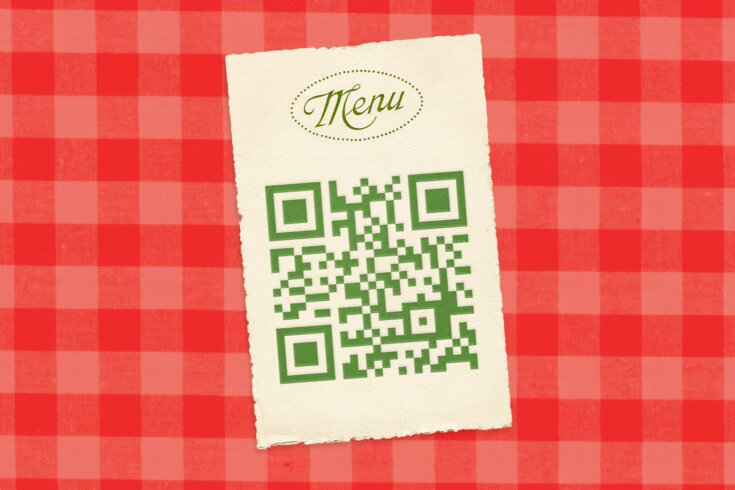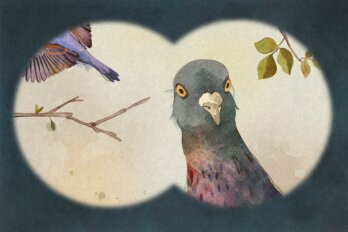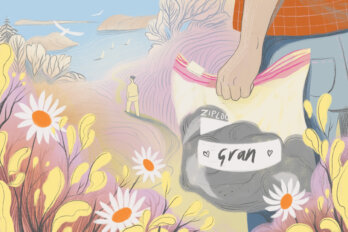I recently travelled to Italy, and the first pleasure of every meal there was reading the menu. Phrases like “risotto al nero di seppia, burrata e ricci di mare”— risotto with cuttlefish ink, burrata, and sea urchins—and “paccheri pestati cunzati con gamberi, pistacchi e bisque”—paccheri pasta with crushed seasonings and with shrimp, pistachio, and bisque—felt like a rich prelude to the food itself. On a rooftop patio in Florence, I was handed both the regular menu and a supplementary sheet of paper. I happened to be there during white truffle season, and the sheet of paper listed all of the dishes they made with the delicacy. I sat there, literally under the Tuscan sun, feeling like a character in a book—one that was very unlike my everyday self.
One of the chief pleasures I get from reading is in poring over the descriptions of food. Give me a banquet scene or a dinner party where the wine pairs perfectly with both the entrée and whatever dramatic revelation is about to come, and I am rapt. Battle scenes bore me, but reading a character’s grocery list enchants me. Maybe that’s why I love restaurant menus so much—a well-written one can feel like a piece of literature in and of itself.
Part of the magic of those Italian meals was not just in reading the menus but in encountering them as physical objects, feeling their weight in my hands and touching the grain of their paper. There was a world of difference from the last menu I’d encountered in North America, which had to be accessed via QR code. That meal had been at a nice restaurant, with flowers on every table and friendly service, but having to begin my meal by squinting at a smudgy screen did somewhat take away from the experience.
QR codes, or quick response codes, aren’t new—they’ve been around since 1994, though they weren’t initially widely adopted outside of Asia. During the pandemic, their ability to offer contact-free interactions led to a rise in their use in the rest of the world, including at restaurants. But even as more and more restrictions were dropped, many of the QR code menus stayed. Hospitality Technology’s 2022 Restaurant Technology Study reported that 66 percent of restaurants in the US used QR code menus, and 19 percent of restaurants planned on adding them. The stats for Canadian restaurants are similar, according to the Toronto Star, which pointed to a Dalhousie University survey that indicated three out of every five Canadians used QR codes at restaurants or grocery stores in August 2021.
My complaints with QR code menus are minor but many. I love the communal aspect of dining out with friends or family, and I hate the way that QR code menus take me out of the shared moment and force me to look at my phone (which, of course, leads me down the rabbit hole of checking my various notifications). I hate the way QR code menus mean scrolling, pinching to adjust size, and sometimes juggling between multiple tabs instead of just having to glance over a page or two.
There are larger issues too: websites with menus on them can track consumer behaviour, one more tiny erosion of our everyday privacy. QR code menus also mean that people need access to a smart phone or some other kind of device and, if they do have one, that they possess a certain level of tech savviness, which excludes some potential patrons. And as Bloomberg reported in 2021, technology that promotes contactless dining has already been linked to job losses in the service industry.
I’m not alone in my dislike of QR codes. In 2022, Conor Friedersdorf wrote an impassioned polemic against them for The Atlantic, and in 2023, the New York Times published an article on their alleged demise, full of quotes from people who loathe them. Even a brief search for the term “QR code menu” on X (formerly known as Twitter) will show you how deeply unpopular they are—one of my favourites, from user @mlokeshceo, simply says, “Menu > QR code.” Succinct and true!
Physical menus are more than just aesthetically pleasing; they can also serve as important historical documents. The New York Public Library has approximately 45,000 menus dating from the 1840s, a collection that they’re in the process of digitizing through their “What’s on the menu?” project, and it’s amazing how much can be gleaned from those documents. The first and most obvious piece of information is what people were eating in a particular time and place—along with how much (or little) they paid for it. One of the menus in the NYPL’s collection is from Mart Ackerman’s Saloon in Toronto, where, back in 1856, diners could get a porterhouse steak with a choice of sides for $0.50—about $12 in today’s terms—accompanied by a glass of Siberian cobbler, ladies’ fancy punch, or a cocktail simply called the eye opener, all priced $0.13—$1.50 today—or under. But there’s so much more that can be learned from these menus beyond just items and prices.
“I think the menus are really important because they’re archival traces of what people are eating, or what people are purchasing, or have the opportunity to purchase,” says writer and cultural historian L. Sasha Gora. “They tell so many different histories. These can be environmental histories—so, really thinking about how certain ingredients disappear, or reappear, or appear to begin with.”
Gora leads a research group at the University of Augsburg dedicated to the culinary environmental humanities. Among other themes, the group has explored the idea of culinary extinction—namely, what happens when the animals and plants used for a popular food go extinct because we have eaten them out of existence? Take the passenger pigeon, for example, which died out in the early twentieth century thanks to overhunting. As it was going nearly extinct, you would think it would be disappearing from restaurant menus too. And yet, as passenger pigeon numbers rapidly declined, passenger pigeon pie was still on the menu, according to Gora, at the storied Delmonico’s Restaurant in New York City. Gora says it’s possible that the pie really did contain passenger pigeon meat, but it’s also possible that it was the meat of some other, more common pigeon. Either way, the menu gave customers a perception of abundance even as their appetites decimated the ecology around them.
Menus can also give us insight into attitudes toward gender. One fascinating example from history is the so-called “ladies’ menu”—a menu printed without prices so that women wouldn’t know how much their dates were spending on them (the practice mostly disappeared after a California woman threatened a restaurant with a discrimination lawsuit). Gora has an example relating to gender and menus from her own life too. In an essay titled “Today’s Special: Reading Menus as Cultural Texts,” she recalls working as a cook at a restaurant that served two versions of the same meal: “The Dirty Brunch” and “The Clean Brunch.” “The Dirty” came with bacon and sausages and, her boss told her, tended to be ordered by men; “The Clean,” by contrast, came with hummus and salad and tended to be ordered by women.
But most of all, menus tell us about things that are ephemeral: foods, yes, but also often the places that serve that food as well. “A restaurant opens, and then it can run for a while, and then it closes, and then there are very few traces left,” says Gora. “So you don’t know what foods were being served, you don’t know how they were being contextualized. But if you have a menu, it actualizes the food, it preserves what was happening in the restaurant.”
I can’t imagine that lunch in Florence would have been quite as thrilling if, instead of holding the leatherbound wine list in my hands and running my finger down the (extensive) inventory of options, the server had directed me toward the QR code for a digital menu. That meal was a moment—with perfect weather, a view of the Ponte Vecchio, and the strongest negroni I’ve ever had the good fortune to come across—and I’m glad that I was able to be fully in it, no screens involved. And if any future historians are wondering, the ravioli with fresh white truffles was worth every penny.
Correction, January 19, 2024: An earlier version of this article misspelled Conor Friedersdorf’s last name. The Walrus regrets the error.





